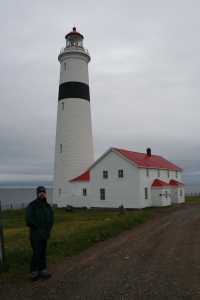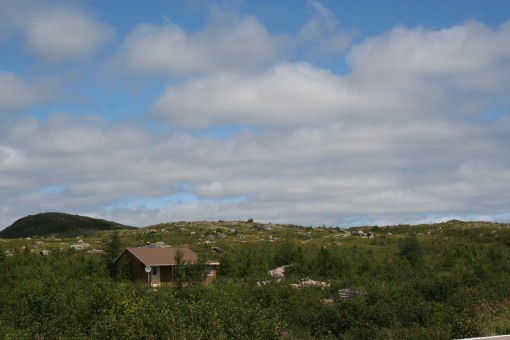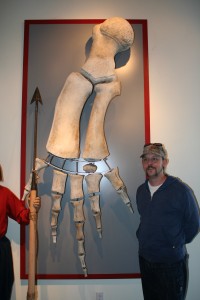Blanc-Sablon is really in Quebec, but it’s literally around the corner from Labrador. To get there, we had to take about a 2 hour ferry ride from St. Barbe, Newfoundland, on the good ship MV Apollo. There was no other way for us to get to the southeast coast of Labrador, as the road doesn’t connect into Quebec and terminates at Cartwright. Labrador is a huge chunk of real estate with not much on it, even roads, so a dedicated traveler could really go down every road. We didn’t because we didn’t get to Northern Labrador, but we did travel a great deal of it.
The road from Blanc-Sablon to Red Bay is known as the Labrador Coastal Drive and is peppered with little communities whose population is usually around a couple of hundred or less. Once we left Blanc-Sablon, our first stop was the visitor’s centre in l’Anse au Claire, which was in an old refurbished church that overlooked a nice sandy beach. Even though the weather was gray and chilly for August, we saw a couple getting married on the beach. Inside the visitor centre there were quite a few displays, and I bought a little book about the plants of Labrador. It was here we saw for the first of many times what Jacques Cartier wrote when he first saw Labrador; “The land should not be called New Land, being composed of stones and horrible rugged rocks…. I did not see one cartload of earth and yet I landed in many places… there is nothing but moss and short, stunted shrub. I am rather inclined to believe that this is the land God gave to Cain”. Labradorians seem really proud of that.
From there it was a short drive to l’Anse Amour. The only thing—and I do mean the only thing—in L’Anse Amour is the oldest known funeral monument in the “new world”. It’s about 7500 years old and it’s the grave site of an adolescent kid. Despite the fact it is one of the few tourist attractions of Labrador, there is not much fanfare about it—just a plaque explaining what it is. Around the corner from that, and within walking distance, is Point Amour. Point Amour has a single digit population, and they must all live in the house next to the lighthouse because that was the only house I saw. The lighthouse is the second tallest in Canada, and has a lot more to look at than a funeral mound. We climbed to the top and while we were there we saw a whale right off the shore from where we were!
The lighthouse has a whole room dedicated to shipwrecks that happened in the Labrador Straits—the water is rough so there have been a lot of them. It also has a “living heritage museum” where we caught the tail end of a story involving chickens accidentally being plucked alive and the sweaters that were subsequently knit for them. I had a very good talk with one museum lady about the plants of the area. She drinks Juniper tea every day for her health. The Juniper plants are different from the Juniper trees in BC. They are bushes that grow low to the ground. She also got me to try some Alexander, which is a bushy little plant that grows near the sea that the locals eat for greens. It was bitterlicious! When we left the lighthouse we walked around a bit and I tried to identify the different plants using the botanical guide.
I think the largest town along this part of the Labrador coast is l’Anse au Loup, and it has a liquor store inside the Marine supply place, where the girl working behind the counter looked about 14. We like to buy locally produced products, and we bought some Ragged Rock Rum, even though neither of us like rum, and a bottle of Rodrigues Blueberry wine and another of Blueberry/Blackcurrent wine. We didn’t have great expectations for the wine, (which, it turned out, was actually produced in Newfoundland), and didn’t drink it until much later, and when we did we were pleasantly surprised by the excellent quality of it, and wished we had bought more.
Like Newfoundland, Labrador doesn’t grow a lot of produce but they do have really a lot of wild berries. We happened to be in l’Anse au Loup for the tail end of their annual Bakeapple Festival. The Big Deal of l’Anse au Loup is the arena, which is the only indoor recreational area for that whole part of the coast, and that night there was to be the Bakeapple dance! We decided to go make dinner and then attend this dance.
We found an inactive quarry near l’Anse au Loup that would make a fine overnight camp spot, and we cooked a bit of veggie stir fry, but because of the quality of vegetables we had been getting, it wasn’t a very good meal. Even though we were near the water there were a lot of black flies and mosquitoes about so we just stayed in the van most of the time. The only other wildlife we saw was a beautiful red fox who was hanging outside the van, circling, leaving and coming back. Foxes are littler beggars, so I guess it was hoping for some scraps. I tried to get a picture, but it was too wily for me.
We assumed, wrongly, that there wasn’t that much to do in l’Anse au Loup and that people would get to the dance fairly early, but hardly anyone was there yet. After spending 3 weeks in Newfoundland we had become used to the friendliness of Newfoundlanders but we were met by the Labradorians with detached indifference. They weren’t rude or anything, they just seemed absolutely uncurious and unimpressed by our touristy presence. This turned out to be a common circumstance all throughout Labrador, and we would later find out it was because of the Labradorian customs of social etiquette—their house is your house, and you are expected to make yourself completely at home, including helping yourself to the fridge, and it would be rude to make a fuss over you because that would imply that your presence was special and not just a matter of course. Something like that. At the time I thought maybe it was because Labradorians are so hardy and self-sufficient they think people like us are lameass softies. But whatever it was, they weren’t at all unfriendly, just not effusive or overly conversational with us.

Greatest Hits Album by Trooper
We shared a moose burger and then as the place started filling up the band played rock covers and we danced a bit. I guess there aren’t a lot of garage bands in Labrador because the musicians were from Newfoundland. I had my first and only minutes of homesickness on the Cross Canada Boogie Bus Adventure of 2008 when the band played “Here for a Good Time” by Trooper. It’s a song about Vancouver and right then I felt very far away from home. That only lasted the duration of the song, though, and when that ended I was again glad to be where I was.
We slept in the Foxes quarry and it was too bad the black flies made stargazing for any amount of time impossible because you never saw such a sky! There’s no pollution of light or industry and the sky was totally clear that night and you could see a kabillion gazillion stars. In the morning we breakfasted at the Oceanview Resort in West St. Modeste . The menu had a lot of fish on it, and wild Caribou steak, and because it was the tail end of the Bakeapple Festival, I had a square made with oatmeal and bakeapples for dessert. Then we spent a lot of time in the lobby using the payphone, because Step’s cell phone service had conked out long ago, and who knew when we would next have access to a phone?
The communities started being more spaced out and we were driving through big expanses of scrubby wilderness until we got to Red Bay. In the 1500’s, Red Bay had a really serious whaling concern going on with the Basque people. In fact, the Basque’s have been considered responsible for the almost extinction of the North Atlantic Right Whale (so called because it was the “right” whale to hunt), but this has recently been questioned as not being accurate. Anyway, it was a hot spot for this kind of activity, and the first known industrial enterprise was set up here. Across from the town of Red Bay is a little island called Saddle Island that has the archeological sites. One spot had these massive, in ground boiling vats where the whale blubber was melted down for oil. (The stench must have been quite incredible). There is a cemetery there with a lot of Basque fishermen buried in it. Also, there is an old galleon sunk in the ocean there, ironically very near another ship skeleton that ran aground on the island maybe in the 1960’s.
We didn’t actually go on to Saddle Island—we just looked at it across the water—but we still saw a lot because of the museums are on the mainland. The first is called a “Orientation Centre” that just has some whale fin bones and a 400 year old somewhat restored fishing boat called a “chulapa”. You only pay one fee—I think we paid something like $7 each— to go into the orientation centre and that entitles you to go to the Interpretive Centre as well. The Basque whaling operation was so huge there are a lot of artifacts surviving from that time which makes the interpretive centre very interesting, and you can really get a clear picture of what life was like for these hunters. We spent quite a bit of time there.
Red Bay itself is a charming little town, and it’s also at the tail end of the Labrador Coastal Drive, and that’s where the pavement ends. From here we embarked on the most rugged part of our cross Canada adventure, the 958 kilometres of gravel road winding through northern wilderness that is known as the Trans-Labrador Highway.









